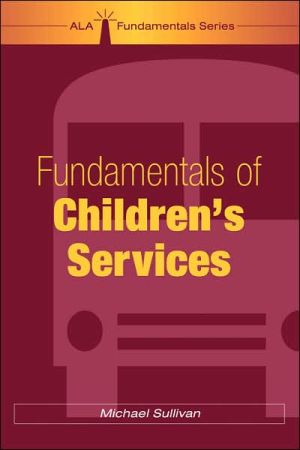Fundamentals Of Children's Services
With more than one-third of library users under the age of 12, it may be said that children's services drive public libraries. Still, many administrators don't fully appreciate how integral these services are to their institutions.\ Michael Sullivan, best-selling author of Connecting Boys with Books (ALA Editions, 2003), conducts a friendly tour in this comprehensive reference, covering both innovative and standard practices in children's services. From collection development and programming...
Search in google:
Aimed at librarians, administrators, and trustees, this volume surveys both standard and innovative practices in children's library services. It opens with a discussion of how children's services fit into the overall mission of the library. Other topics include (for example) the acquisition of materials, the provision of after-school services, and the development of family literacy programming. Administrative issues such as budgeting and public relations are covered in the final section. Sullivan is director of the Weeks Public Library in Greenland, New Hampshire. Annotation ©2005 Book News, Inc., Portland, OR School Library Journal This volume is "intended to be a guide for the new or future children's librarian." As such, it reads like a textbook and covers the gamut of topics that you would expect to find in such a text-collection development (purposes, selection and acquisition, organizing, cataloging, evaluation, deselection); services (after-school, reference, readers' advisory, the Internet); programming (storyhours, book-discussion groups, booktalking, summer reading clubs, family programs, family literacy); and management, administration, and leadership (budget, finance, planning, policy and procedures, public relations, promotion, marketing, professional development). Sullivan also discusses the role of children's services and the principles of children's librarianship. Topics are not covered in great depth but the content does touch on the essential elements. Insets within the chapters discuss issues such as librarian shortages and pay equity, service to boys, children and privacy, and library programs and copyright. Other insets give suggested titles for storyhours, a sample press release, and Web resources. While the book is probably redundant for practicing children's librarians, it is well suited for novices or as a guide for library directors who are not sure of the place of children's services in the public library.-Janet Hilbun, Texas Woman's University, Denton Copyright 2006 Reed Business Information.
1Where we fit in72Principles of children's librarianship123Whom do children's librarians serve?214Purposes and components405Selection and acquisition516Organization and cataloging607Evaluation and deselection/weeding688After-school services799Reference8810Readers' advisory9611The Internet10612Story hours12213Book discussion groups13614Booktalking14115Entertainment and enrichment programs15116Summer reading programs16117Family programs and family literacy17018Budget and finance17919Planning18920Policy and procedures19821Public relations, promotion, and marketing20322Professional development213App. ACompetencies for librarians serving children in public libraries231App. BLibrary bill of rights238App. CCode of ethics of the American Library Association239
\ School Library JournalThis volume is "intended to be a guide for the new or future children's librarian." As such, it reads like a textbook and covers the gamut of topics that you would expect to find in such a text-collection development (purposes, selection and acquisition, organizing, cataloging, evaluation, deselection); services (after-school, reference, readers' advisory, the Internet); programming (storyhours, book-discussion groups, booktalking, summer reading clubs, family programs, family literacy); and management, administration, and leadership (budget, finance, planning, policy and procedures, public relations, promotion, marketing, professional development). Sullivan also discusses the role of children's services and the principles of children's librarianship. Topics are not covered in great depth but the content does touch on the essential elements. Insets within the chapters discuss issues such as librarian shortages and pay equity, service to boys, children and privacy, and library programs and copyright. Other insets give suggested titles for storyhours, a sample press release, and Web resources. While the book is probably redundant for practicing children's librarians, it is well suited for novices or as a guide for library directors who are not sure of the place of children's services in the public library.-Janet Hilbun, Texas Woman's University, Denton Copyright 2006 Reed Business Information.\ \







